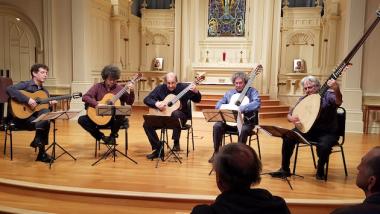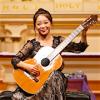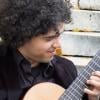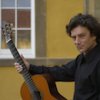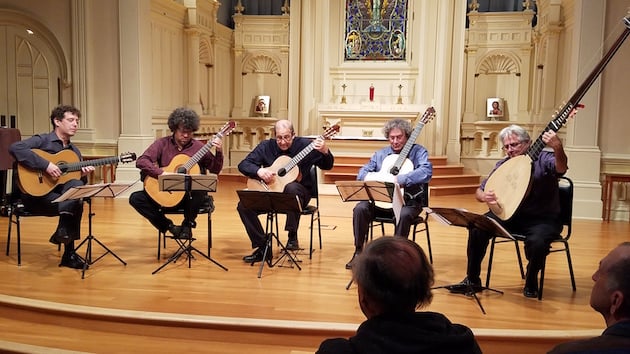
This isn’t the first year in which Richard Patterson’s Omni Foundation, through its Dynamite Guitars series, has provided a showcase for the virtuosity of the San Francisco Conservatory of Music’s guitar faculty. But last Saturday’s concert, dubbed The Maestros of 50 Oak Street (the SFCM address), may have more than ever displayed the breadth and depth of the teachers’ talents and, by implication, the diverse opportunities imparted to their students, many of whom were in the audience at St. Mark’s Lutheran Church.
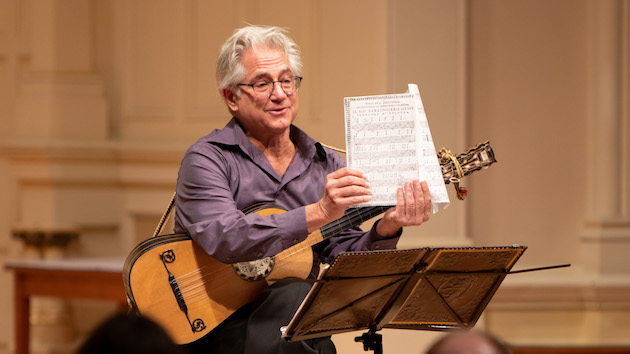
Consider Richard Savino, whose set was performed on an 1830 Baroque guitar and a John Rollins copy of a Jean Voboam instrument from the late 17th century. The modest, sweet, and courtly Ciaconna by Domenico Pellegrini, from earlier in that century, matched the limited range and volume of the Baroque instrument, with theme and variations in basic harmony. The Grave and Allegro from Santiago de Murcia and the next century, evinced the evolution of composition with more complex voicings and harmonies and an arguable affinity to Bach. The amiable Savino also delivered a student-friendly mini-lecture to the audience as he switched to the slightly larger, “early classic” instrument for two sonatas by Juan Antonio Vargas y Guzman. He worked deeper and fuller tones (though less precise than those heard from contemporary instruments) in an Andante, and then showcased more engaging dynamics on a tarantella-like Allegro.
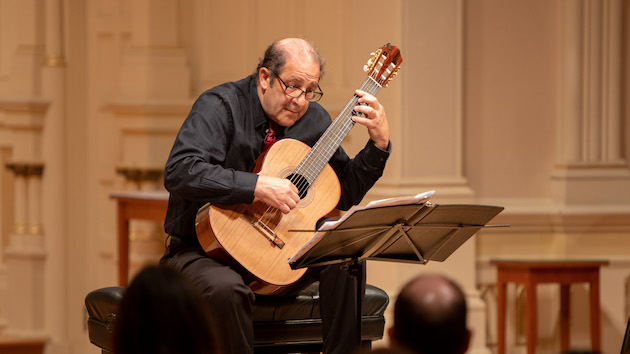
Lawrence Ferrara, who will retire after this semester, displayed a more angular, less smooth delivery than some of his colleagues, performing on an instrument from Australian luthier Greg Smallman (as did Judicaël Perroy). The counterpoint in Antonio Laura’s El Niño, though, was nicely articulated here and even more so on the 20th-century Venezuelan composer’s more familiar El Marabino. The shape of Brazilian Egberto Gismonti’s Palhaço, as arranged by former SFCM faculty member Sérgio Assad, seemed somehow foggy, perhaps demanding a clearer interpretation. In going it alone on three pieces by Astor Piazzolla, Ferrera, who wrote the arrangements, mostly missed the rigid testosterone pulse expected of tango ensembles, though he came close to finding it on the popular Libertango, in the bargain stretching his fretboard technique towards the wide range of the Argentinian bandoneon. On the other Piazzolla pieces — Adiós Nonino and Oblivion — the absence of percussive instrumentation and technique, curiously, allowed Ferrara’s guitar to better elicit the almost Bachian beauty in the Argentinian composer’s melodies.

There was pleasing evidence of why Judicaël Perroy was relatively recently recruited to the SFCM faculty, as the young guitarist brought a glowing tone and thoughtful but lyrical dynamics to Bach’s Fugue BWV 997, originally written for lute. Perhaps the longest piece of the evening, it proceeded with engaging fluvial pacing in Perroy’s hands. The fugue form was worked well with tonal contrasts between the sonorous lower strings and the bright higher strings. The guitarist’s left hand on Alexander Scriabin’s Prelude Op. 9 pour la main gauche (for the left hand) was given an admirable athletic workout on the fretboard, and the piece’s ruminative and empathic qualities were effectively elicited.
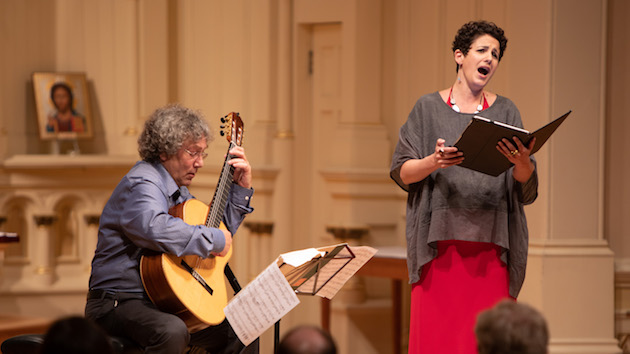
After intermission SFCM guitar department chair David Tanenbaum, on a spruce-top guitar crafted by Stephan Connor on Cape Cod, paired with soprano Ann Moss on six folksong arrangements by Benjamin Britten. Apparently composed for Julian Bream and Peter Pears, Britten displays an understanding of guitar perhaps unknown to many of his fans, though conveyed with familiar playfulness and innovation. Tanenbaum inhabited this spirit easily, showcasing the composer’s variety of approaches to succeeding verses of each song, sometimes dancey (“Sailor-boy”), sometimes elusive (the diminished and other “alternative” chords in “Bonny at Morn”). The vocal setting stays fairly true to the folk origins and thus in pleasant contrast to the guitar accompaniment, and Moss’s fresh, sweet but sinewy soprano told the songs’ stories clearly and compellingly. Tanenbaum proved equally assured and supportive, his technique particularly impressive in the anguished arpeggiation of “The Shooting of his Dear.”
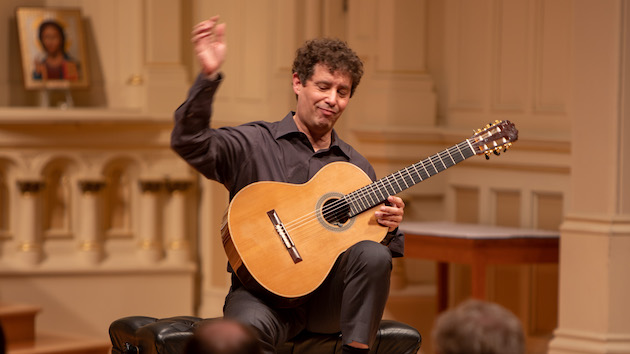
Closing the solo performances, Marc Teicholz selected three jazz arrangements by the late Roland Dyens, who himself performed guitar in both classical and jazz contexts. Playing a cedar-top Stephan Connor instrument, Teicholz began by invoking the “head” of “All of Me” in overtones, then artfully brought out the contrapuntal potential in the jazz standard, setting a rocking bass against the high melody line. In this and the other two songs, Dyens worked an interesting Richard Rodgers-like chromatic approach to voice leading at times, delicately intoned by Teicholz. Thelonious Monk’s “Round Midnight” seemed to require an alternate tuning, after which the guitarist introduced an alluring noir intro and bluesy note bending. A tendency for Dyens’s artfulness to rather occlude the structure and beauty of the jazz original, somewhat apparent in “All of Me,” became a bit more questionable here. This was music not for a jazz guitarist, but for a classical concertizer visiting jazz, and the result sometimes degenerated into doodling. “Take the A Train” stayed truer to form, and was well-syncopated by Teicholz, though he was somewhat confounded by the demands of the rapid arpeggiation of the “shout chorus.”
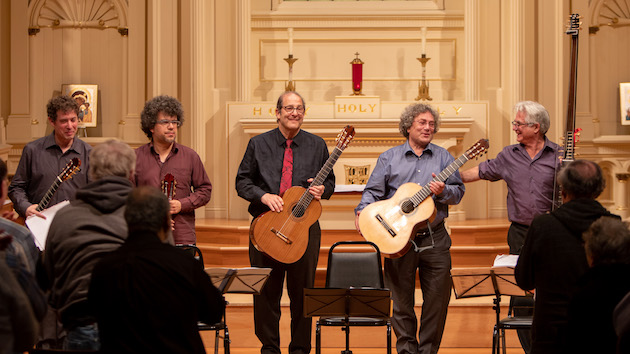
The entire faculty convened on stage for Monteverdi’s Orfeo Suite, arranged by Swiss composer Jürg Kindle, with Savino exchanging his diminutive early guitars for a gargantuan Baroque theorbo, fashioned by San Franciscan Mel Wong from a 17th-century Tieffenbrucker model. Teicholz maintained the high-voiced lead, with the complementary voicings handsomely and effectively spread among his colleagues. The allegro section especially elicited admiration of the ensemble’s coordination and negotiation of tricky Baroque rhythmic changeups. And the ebullient response to an extended standing ovation inspired everyone present with the good fellowship shared by these committed and practiced instructors.

